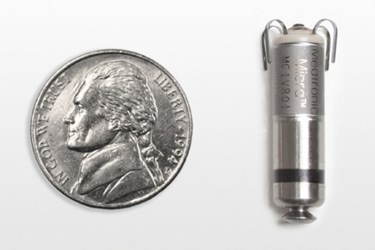Medtronic's Micra, Word's Smallest Pacemaker, Approved by FDA

With approval from the FDA, Medtronic is prepared to launch its Micra Transcatheter Pacing System (TPS), the first leadless pacemaker to be marketed in the U.S. Because the Micra is delivered through a catheter and fixed to the heart muscle without the traditional wiring, developers believe it will reduce complications commonly associated with pacemakers, and is the beginning of a major paradigm shift in the cardiac device industry.
The Micra is one-tenth the size of traditional pacemakers and does away with wiring and the “surgical pocket” directly beneath the skin of a patient’s chest, providing cosmetic benefits over the current standard in pacing technology. Though designers incorporated a retrieval feature, the device is designed to be left inside the body and can be switched off in the event that another device is inserted to replace it, according to a press release.
The Micra — which received CE mark approval last year — completed a global clinical study with results published in November in the New England Journal of Medicine. The study demonstrated a 99 percent success rate with implantation, zero instances of dislodgements or systemic infections, and 51 percent fewer instances of major complications after six months versus traditional pacing systems.
Mike Hess, VP Bradycardia R&D CRHF Division of Medtronic, told MDO in a December interview that the clinical trial — which was conducted at 56 centers in over 19 countries — was a significant part of the company’s global marketing strategy.
At this time, Micra is cleared only to assist in pacing the heart’s lower chambers, and is not appropriate for patients with dual-chamber pacing needs, though Hess commented that this indication likely will be Medtronic’s next step.
“I think it’s going to be journey. I don’t think it’s going to be a situation where you flip a switch and suddenly you have a solution for everyone,” said Hess. “We are going to step into it over time, and we will be able to address more patients with each step. I think it is a long-term transition to a new paradigm, and Micra is the first major step in that direction.”
Part of that transition involved a panel hearing hosted by the FDA in February, where the agency invited input from the industry — principally Medtronic and St. Jude, whose leadless pacemaker Nanostim received a CE Mark in 2013 — to help establish a regulatory strategy with leadless pacemakers.
At the hearing, the panel recommended rigorous training for clinicians implanting the device, as well as a national registry that would follow all patients implanted with the device for the duration of its battery life — six to 12 years.
“I think this is a very disruptive technology and it is at the beginning of a long career that we can’t predict,” said David Slotwiner, cardiologist and panel member.
